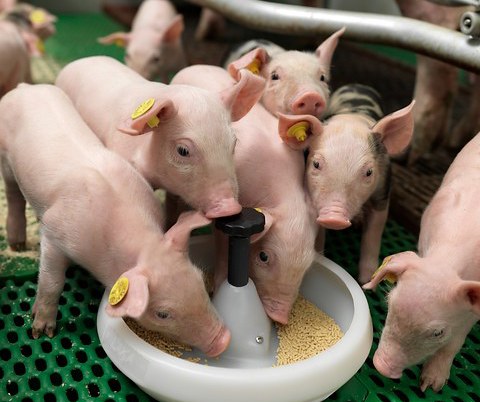
What is the gut?
To understand what ‘gut health’ means, we need to describe the gut and identify its main functions. The gut is a major immune organ because it consists of the largest lymphoid mass of the pig’s body. In addition, the gut is home to millions of microbes, known as the ‘gut microbiota’.
By using the above-mentioned characteristics, we can identify three important functions of the gut:
1. The digestion and absorption of nutrients:Digestion is the result of the enzymatic breakdown of ingested feed and the absorption of nutrients to the blood or lymphoid circulatory systems. This begins in the mouth and continues throughout the gastro-intestinal tract.
Let us consider the following briefly:
The Mouth
The mouth plays a valuable part, not only in the consumption of feed but also for the initial particle size reduction through the mechanical breakdown process of chewing. While teeth are mainly used to grind, and reduce food size and increase surface area, the first action to begin the chemical breakdown of food occurs when feed is mixed with saliva.
The Stomach
The stomach is a muscular organ responsible for storage. It also initiates the breakdown of nutrients, and passes the ingested feed on to the small intestine.
The Small Intestine, Pancreas and Liver
The small intestine is the major site of nutrient absorption, and is divided into three sections. The first section is the duodenum. The duodenum is approximately 12 inches long and is the portion of the small intestine that has ducts from the pancreas, the liver and the gall bladder. The pancreas is responsible for the secretion of insulin and glucagon in response to high or low glucose levels in the body. Upon leaving the duodenum, the feed enters the middle portion of the small intestine, the jejunum. Nutrient absorption continues into the final section of the small intestine, the ileum.
The Large Intestine
The hindgut (large intestine) encompasses four main sections. First, digested feed from the small intestine passes into the caecum. The caecum has two sections; first, a section that has a blind end, where material cannot pass though. The caecum has a second portion where it connects to the colon, where digested feed is passed to the rectum and anus where the remaining feed is excreted. The main function of the large intestine is the absorption of water. The large intestine epithelia have a large capacity for water absorption. The digested feed that passes through the small intestine and into the large intestine initially is very fluid.
2. Providing residence for microbiota
The gut is home to a wide range of bacteria, which is found from the stomach all the way in the colon. These bacteria, like lactobacilli, which are more prevalent towards the end of the intestinal tract, play an essential part in the absorption of nutrients. Healthy microbiota is characterised by a good diversity, a good barrier function and a microbial community composition that is strongly influenced by factors such as nutrient availability and peristalsis.
3. Effective barrier function through the mucosa
The mucosa forms a barrier between the body and the luminal environment. Its role is to allow efficient absorption of nutrients while excluding the passage of pathogens, antigens and toxins.
It is important to note that the gut of the pig is not ‘static’ and the only constant is change. This means that the gut will change continuously as the pig develops and grows. In addition, the composition of gut flora will also change depending on the state of growth. Gut infections can be a major source of efficiency loss and additional costs for veterinary treatment. In addition, nutrient allocation to growth may be compromised as the body of the pig will allocate the necessary nutrients to fight the challenge first and what is left over will go to maintenance and then only to growth.
Good gut health, in young pigs holds the key to improved health and performance and in turn to profitability. We all know that the gut is the largest organ that influences immune function. The first line of defence, so to speak, and it should receive the highest priority. If gut health is not optimal, growth will be compromised and in turn it will impact negatively on profitability.
Optimizing gut health begins with colostrum and milk. It is vital that each piglet has sufficient colostrum as they will rely on this for passive immunity. The quicker each piglet gets to suckle colostrum after birth, the better the chances are of having good immunity. By improving the integrity of the gut wall, we increase the ability to absorb nutrients.
Good gut health offers piglets a good start, and may also contribute to:
- Increased beneficial micro-flora
- Reducing harmful bacteria
- Improving feed intake and average daily gain
- Improving piglet mortality
- Increased profitability
Some factors to consider when looking at gut health:
- Nutrient Sources
Gut integrity can be improved and maintained with the proper selection of ingredients that prevent gut inflammation, increase growth of good bacteria, and decrease water loss. High quality proteins, highly digestible carbohydrates and unique gut environment enhancers together make a feed programme that provides the solid foundation for health and growth.
- Gut Micro Flora
The promotion of the growth of beneficial bacteria like Lactobacillus and Bifidobacteria reduces the population of harmful bacteria through competition for nutrients. Maintaining a good pH level will also help to lower the needed buffering capacity of the stomach as well as maintaining a good environment for favoured bacteria to help in the digestive process.
- Epithelial Junctions
Normal epithelial cells are stacked close together with “tight junctions” that provide a protective barrier in the gut. Damage to these cells through, for example, inflammation causes epithelial cells to separate that lead to “leaky junctions” which allow undigested food particles and toxins to pass through the gut wall.
- Feed Intake
Research showed that less intestinal damage occurred in weaned pigs when feed intake is increased. Higher feed intake can lead to longer intestinal villi, improved absorption of nutrients and the reduction of disease-causing bacteria like E. coli.
- Medications
We know that the use of medication in feed is permitted, but we also understand that the use of medications will be strictly regulated in the near future if - they are still permitted to be used. It has been proved that the use of some feed medications to improve the balance of gut flora and promote growth can be beneficial, but some of these medications, especially some antibiotics, may actually impact negatively on the absorption of nutrients. Always consult your vet before considering the use of medication in feed.
References: The Pigsite, Pig Progress, Animal Science Publications
